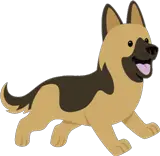Introduction
There’s a rich history woven into the tale of sled dogs, a narrative that spans thousands of years. These incredible canines have been instrumental in human survival in harsh, frigid landscapes, lending their strength and resilience to tasks from hunting to transportation. An integral part of this storied history is the Chukotka sled dog. Known for their endurance and adaptability, these dogs hold a significant place in the lives and culture of the Chukotkan people.
| Characteristic | Details |
|---|---|
| Breed Name | Chukotka Sled Dog |
| Origin | Chukotka Peninsula, Russia |
| Size | Medium to Large |
| Coat and Colors | Double coat; Black, White, Grey, and combinations thereof |
| Temperament | Hard-working, gentle, intelligent, obedient |
| Lifespan | Typically into their teens |
| Diet | High-quality commercial dog food or a traditional diet of fish and game |
| Exercise Requirements | High; Daily exercise required |
| Grooming Needs | Moderate; Regular brushing required |
| Living Conditions | Best suited to cooler climates; Adequate care is needed in warmer climates |
Chukotka Sled Dog Origins
Role in Chukotkan Culture
The Chukotka sled dog has always been more than a pet or a working animal in Chukotkan culture. These dogs are deeply respected and are seen as crucial partners in survival in this challenging environment.
Evolution of the Breed in Arctic Regions
Over generations, these dogs have evolved to endure the arctic conditions of the Chukotka Peninsula. Their specific adaptations have made them uniquely suited to their harsh environment and invaluable to their human companions.
Physical Characteristics of Chukotka Sled Dog
Appearance
Chukotka sled dogs are characterized by their robust and muscular build, indicative of their strength and stamina. They have a double coat and almond-shaped eyes, usually in shades of brown or blue.
Size
These dogs are medium to large, with males typically larger than females. Despite their substantial size, their agility is impressive.
Coat and Colors
Their double coat, designed to withstand severe cold, comes in a variety of colors, including black, white, grey, and combinations thereof.
Temperament and Behavior of Chukotka Sled Dog
General Temperament
Chukotka sled dogs are known for their hard-working, yet gentle nature. They’re intelligent and obedient, displaying an unwavering loyalty to their human family.
Interaction with Humans
These dogs are known to bond strongly with their human handlers, displaying a keen sensitivity to their needs and commands.
Interaction with Other Animals
As pack animals, they interact well with other dogs, often working together harmoniously as a team.
Working Abilities of the Chukotka Sled Dog
Sled Pulling Abilities
These dogs are capable of pulling heavy loads across long distances in the challenging conditions of the Arctic. They have a natural instinct for pulling and teamwork.
Endurance and Adaptability in Harsh Climates
Their evolution in Arctic climates has endowed Chukotka sled dogs with incredible endurance and adaptability to cold, harsh conditions.
Other Roles in Chukotkan Community
Beyond sled pulling, they have also been used for hunting, herding, and as loyal companions.
Training a Chukotka Sled Dog
Basic Obedience Training
Like all dogs, Chukotka sled dogs respond well to positive reinforcement training methods. They are quick learners and eager to please.
Sled Training
Sled training is a specialized process that taps into the dogs’ natural instincts for teamwork and pulling. It typically involves harness training and learning specific commands related to sled work.
Tips for Successful Training
Consistency, patience, and positive reinforcement are key elements for successful training. It’s also important to start training early.
Health and Lifespan of the Chukotka Sled Dog
Common Health Issues
Chukotka sled dogs are generally healthy and resilient, but like all breeds, they can be prone to certain health issues. Regular veterinary check-ups are essential to ensure their well-being.
Average Lifespan
These dogs typically have a long lifespan, often living into their teens. This is due in part to their robust constitution and active lifestyle.
Veterinary Care
Regular veterinary care, including vaccinations, parasite control, and dental care, is important to maintain the health and longevity of the Chukotka sled dog.
Diet and Nutrition for the Chukotka Sled Dog
Traditional Diet
Historically, their diet consisted of fish and game, providing the high protein levels needed for their active lifestyle.
Modern Feeding Recommendations
Today, high-quality commercial dog foods that provide the right balance of proteins, fats, and carbohydrates are recommended. It’s also important to tailor their diet to their age, size, and activity levels.
Care and Maintenance of the Chukotka Sled Dog
Exercise Requirements
These active dogs require daily exercise to keep them healthy and happy. This can include tasks, play, and training activities.
Grooming Needs
Despite their thick coat, they have moderate grooming needs. Regular brushing helps to keep their coat healthy and manage to shed.
Living Conditions
Given their adaptation to cold climates, they are best suited to live in cooler environments. Adequate shelter and care must be ensured if living in warmer climates.
Preserving the Breed and Current Status
Conservation Efforts
There have been several initiatives to preserve and promote this unique and historical breed, given its significance to the Chukotkan culture and the broader canine lineage.
Role in Modern Chukotkan Culture and Beyond
While still serving as working dogs in many Chukotkan communities, they are also increasingly recognized for their remarkable qualities beyond their original geographic boundaries.
How to Support the Breed
Supporting ethical breeding practices and participating in breed conservation programs are great ways to support the Chukotka sled dog.
Adopting a Chukotka Sled Dog
Considerations for Prospective Owners
Bringing a Chukotka sled dog into your life is a long-term commitment. Prospective owners should be aware of their high energy levels and their need for regular exercise. While they’re wonderfully loyal and intelligent, they require a firm, consistent handler who can provide ample opportunities for both physical and mental stimulation.
Where to Adopt
It’s important to consider adoption from rescue organizations or ethical breeders who prioritize the health and well-being of their dogs. As this is a unique breed with specific needs, finding a reputable source from where to adopt can take time and research.
Chukotka Sled Dog in Popular Culture
Depiction in Media and Entertainment
While not as commonly featured in popular culture as some other breeds, the Chukotka sled dog and their kin have had their share of the limelight. Films and books that narrate the gripping tales of survival and adventure in Arctic regions often portray these hardy sled dogs, reflecting their integral role in these narratives.
The Chukotka Sled Dog as a Symbol
The Chukotka sled dog, with its resilience, loyalty, and unwavering work ethic, is often seen as a symbol of the spirit of the Arctic region – a testament to life’s tenacity in the face of harsh and challenging conditions.
Conclusion
The journey of understanding the Chukotka sled dog has taken us through its unique characteristics, its vital role in human history, and its continued significance in the modern world. In appreciation of this magnificent breed, it is important to encourage responsible ownership and ethical breeding practices. By doing so, we ensure their survival and continued role as our invaluable companions in the years to come.


